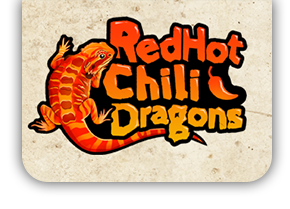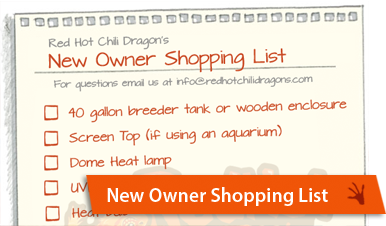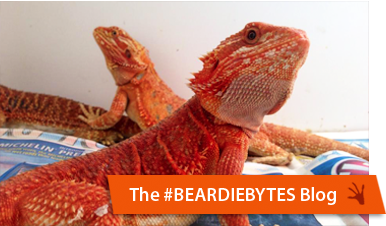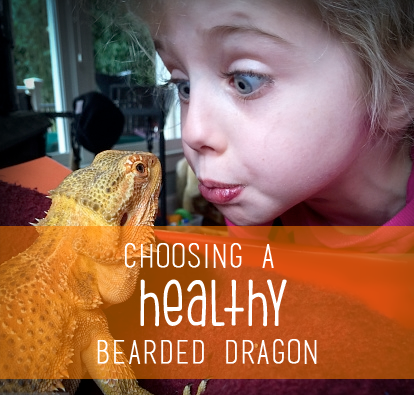Buying your first bearded dragon is always very exciting and I know you just can’t wait to bring the dragon home and start interacting with it. But whoaaa slow down tiger, let’s first take a look at how to choose the perfect dragon for you. Now I’m not talking about blind bearded dates here, I’m talking about how to differentiate between a healthy dragon and one that may not be fairing well.
There are a couple of signs you should look at first when picking out a dragon. The first clue is to see how alert and active the dragon is. Is it perked up and looking around being attentive? Can it support it’s own body weight? A healthy dragon will not be lethargic and will have the energy to support its body weight when walking, running and sitting.
The second clue is to look over it’s body. First with the eyes. Are the eyes clear and free of any crusting, runny or have pus? And more importantly are they open? Dragons that are stressed out will often be hiding and keep both eyes firmly shut. Try to see if you can watch the dragon either eat or move around its enclosure to make sure it’s active. Here at RHCD we like sending customer’s lots of pictures and videos of the dragons they are interested in. That way in the video they can watch us interact with the dragon and see for themselves that the dragon is healthy.
Make sure to look for any injuries on their body? Open wounds or cuts? If there was an injury is it healed and not infected? We have beardies that have had their tails’ nipped as a hatchlings. The tails healed with no worry and the dragon’s are happy and healthy. But a limb that has been nipped and was not taken well cared for can become infected and further amputation of the limb could be needed. Unlike some species of lizards, bearded dragons do not regrow their tails, toes, or limbs.
Another clue is to look at the overall body condition. How are the dragon’s fat stores and hydration level? Make sure the belly area is nice and round with thick limbs. I mean who doesn’t like a curvaceous dragon am I right? Ahem. Make sure the dragon’s hip bones aren’t showing as well as the legs and tail not looking like skeletons. That is a sign of a malnourished beardie. Also take a look at the fat pads at the base of the tail and top of the head. This can help you determine if the dragon is dehydrated or not. A sick dragon is often dehydrated and will have sunken in fat pads.
Alright, alright so now you know the telltale signs of a healthy bearded dragon. So where do you get one?!
Where to find Bearded Dragons for Sale?
A Reputable Breeder
This is my preferred choice when buying new reptiles. Through breeders I can learn so much more about the animal I’m buying. Exactly how old it is, who the parents are and what foods it’s currently eating. A good breeder will also help you throughout the whole buying process as well as be there for you after the initial purchase. They should be able to help guide you through the ins and outs of beardie care.
As with pet stores there are some bad breeders that go along with the good ones. Remembering the clues we talked about earlier, always look at the animals being sold to you to ensure that they are healthy and happy.
Once you’ve found a breeder, don’t be afraid to ask them questions about their breeding stock, what genetic lines they have and look up any reviews on the breeder.
The Neighborhood Pet Store
Ah the good ol’ petstore. The place where many first time pets have been bought and where many first timer mistakes are made too! I’ll start with my own story. We bought our first reptile 13 or so years ago from a local pet store. It was a chinese water dragon. Talking with the employee we were directed to purchase a huuuuge list of supplies, a 20 gallon tank and the dragon itself. I was told this was all we needed to keep our lizard healthy and happy. Boy was I wrong! Over the course of a few months we couldn’t help but notice our lizard wasn’t thriving. In fact it was the very opposite! He quickly began became lethargic and hid with his eyes closed. We went online to a forum to seek help and we were mortified! The pet store employee that we had entrusted was completely wrong. We learned that over half of the items we bought weren’t needed. And that 20 gallon tank he was supposed to live in happily? Yup! waaaay too small. We quickly made the changes and our lil guy bounced back quickly. Unfortunately I hear the same story too often.
The lesson here? Always do your own research prior to buying an animal and even if the petstore employees should know all about the care of an animal, it is much safer to do your own research and education. Knowledge is power! Research the items that you need to buy for your dragon first and make a shopping list of them.
Don’t get me wrong, some pet stores are great! Knowledgeable staff and great care in the animals. But some stores are not that lucky. Some pet stores know nothing at all about reptiles and many of their lizards are lethargic and essentially dying in those glass display tanks. As awful as it is, try your best not to buy these animals and rescue it. You’re amazing intentions will only allow the pet store to order more animals to replace the one you brought home. The cycle won’t end unless no one buys from them discouraging them to stock up on more animals.




